Each time I visit the ruined Wuchang Temple (武昌宮) in Nantou County’s Jiji Township (集集), I ask myself the same question: Back in the 1990s, did one of the shrine’s office holders pray — or privately hope — that somehow the temple might become so famous people would flock from afar?
Like the characters in the short story The Monkey Paw, they got what they wanted, but at a tremendous cost. There was no miracle. Instead, the 921 Earthquake rendered the temple unusable and unrepairable. The disaster, which occurred in the early hours of Sept. 21, 1999, is also known as the Jiji Earthquake because the epicenter was right here.
The temple’s first floor almost entirely collapsed. The slant of the drum tower now approximates that of the Leaning Tower of Pisa. The three Taoist immortals which represent blessings, wealth and longevity, and who formerly stood at the highest point of the roof, are now face-down on the tiles, like drunks who can’t rise from the sidewalk. Only twisted rebar keeps them from sliding down to the ground, leaving these icons with no more dignity than sailors about to be keelhauled.
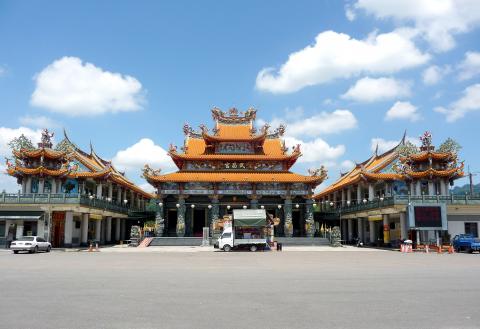
Photo: Steven Crook
Visitors can walk all the way around the ruin. At the back there’s a somewhat formal gate, secured with a shiny padlock, that looks as though it provides access to the interior. If you want to peer inside, bring a powerful flashlight.
It’s not as if the temple was struggling before the earthquake. Between 1989 and 1997, NT$70 million was spent on the construction of this hall of worship. Xuantian Shangdi (玄天上帝, Emperor of the Mysterious Heaven) and other deities have been worshiped on this site since 1903, but the temple wasn’t formally established until 20 years later, when there was a “division of incense” (分靈) from Nanyan Temple (南岩宮) in China’s Hubei Province. Some local faithful claim the beard on Wuchang Temple’s Jade Emperor (玉皇) figurine has grown since the earthquake, and continues to lengthen.
For more than a decade after the disaster, the Emperor of the Mysterious Heaven, the Jade Emperor and the temple’s other spirit effigies were housed in a tin shack across the road from the ruins. Meanwhile, tour-bus groups and individual travelers came from all over Taiwan to see and photograph the wreckage from which they were extracted. Visitors and locals made donations, and work was eventually begun on a permanent replacement.
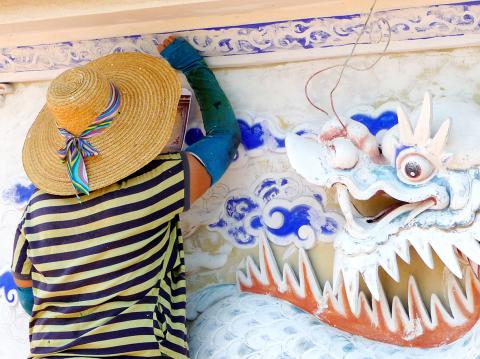
Photo: Steven Crook
The new Wuchang Temple is about twice the size, and directly in front, of the original. Inaugurated in October 2013, it’s as colorful and intricate as you’d expect. Inside, however, I haven’t spotted anything remotely innovative, and I feel that an opportunity has been missed. The Lingxiao Hall (凌霄寶殿) at Tainan’s Nankunshen Daitian Temple (南鯤鯓代天府) shows what can be achieved when a temple management committee decides to step beyond the conventional.
Even if the 21st-century Wuchang Temple is a little disappointing, the ruin behind it surely ranks as one of Taiwan’s top three “earthquake relics,” the others being Yutengping Bridge (魚藤坪斷橋) in Miaoli County’s Sanyi Township and the devastated campus of Guangfu Junior High and Elementary School (光復中小學) in Taichung. The last of these has been preserved as part of the 921 Earthquake Museum (九二一地震教育園區).
From Wuchang Temple it’s a 15-minute walk to Mingxin Academy of Classical Learning (明新書院). Established in 1878 and moved to its current location 30 years later, the academy was endowed by merchants who had made their fortunes from camphor. Local boys came here to be educated in the Chinese classics. Nowadays it functions as both a tourist attraction and a shrine dedicated to Wenchang Dijun (文昌帝君), a Taoist deity often prayed to by Taiwanese hoping for success in major examinations.
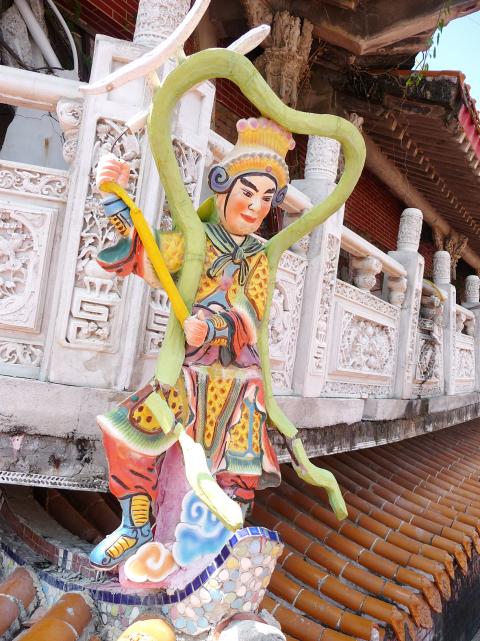
Photo: Steven Crook
From the academy you can enjoy good views of the mountains that surround Jiji, but if you’re hoping to take photos of the central structure, you might be frustrated. At the time of my visit it was shrouded in scaffolding and netting. Two young artisans were retouching paintings around the complex.
Their supervisor told me the renovation was “a small case” (indeed, I couldn’t see anything wrong with the academy apart from faded colors) and suggested I take a look at the cluster of Japanese-era dormitories near the corner of Minsheng Road and Jhongshan Street. There, preservation efforts have just started, and a great deal needs to be done. A worker putting in temporary props to shore up the buildings pointed out that much of the original woodwork has survived well because it’s hinoki (檜木, a type of cypress).
Next door to Mingxin Academy there’s a central government unit that plays a crucial role in understanding and preserving Taiwan’s biodiversity. The Endemic Species Research Institute (特有生物研究保育中心, tesrieng.tesri.gov.tw) also aims to educate the public, and the Conservation Education Center (open 9am to 4:30pm, Tuesday to Sunday, admission NT$60) does a fine job of introducing Taiwan’s endemic birds, beetles, butterflies, fish, snails, and plants.
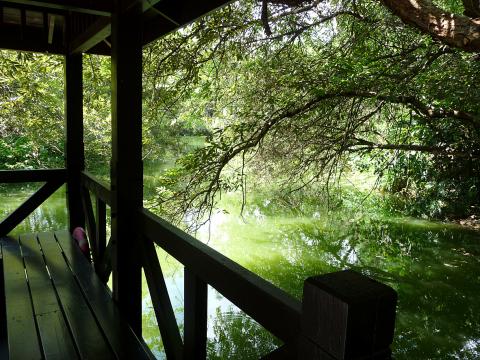
Photo: Steven Crook
If you have an interest in nature, the adjacent Ecological Education Park (open 8:30am to 4:30 daily; free admission) will enthrall you for an hour or more. During the hot season you can expect to see some gorgeous dragonflies — but make yourself mosquito-proof before entering.
Placing the institute in Jiji makes absolute sense, of course. The town is between the lowlands and the highlands. It’s near waterways and substantial forests, and it can also be a stepping stone to a number of alluring places deep in Taiwan’s interior.
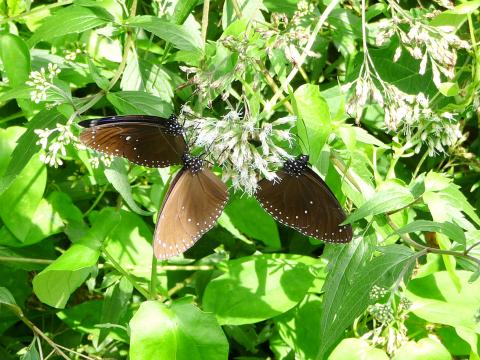
Photo: Steven Crook
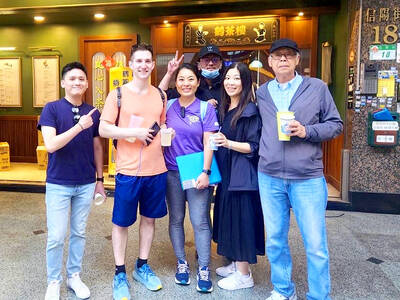
Eric Finkelstein is a world record junkie. The American’s Guinness World Records include the largest flag mosaic made from table tennis balls, the longest table tennis serve and eating at the most Michelin-starred restaurants in 24 hours in New York. Many would probably share the opinion of Finkelstein’s sister when talking about his records: “You’re a lunatic.” But that’s not stopping him from his next big feat, and this time he is teaming up with his wife, Taiwanese native Jackie Cheng (鄭佳祺): visit and purchase a
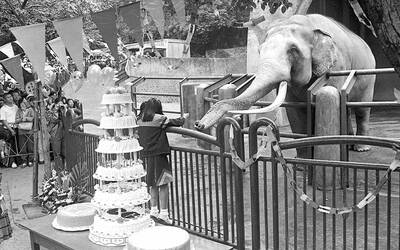
April 7 to April 13 After spending over two years with the Republic of China (ROC) Army, A-Mei (阿美) boarded a ship in April 1947 bound for Taiwan. But instead of walking on board with his comrades, his roughly 5-tonne body was lifted using a cargo net. He wasn’t the only elephant; A-Lan (阿蘭) and A-Pei (阿沛) were also on board. The trio had been through hell since they’d been captured by the Japanese Army in Myanmar to transport supplies during World War II. The pachyderms were seized by the ROC New 1st Army’s 30th Division in January 1945, serving
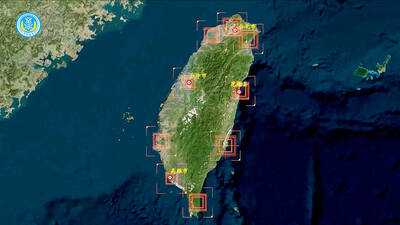
The People’s Republic of China (PRC) last week offered us a glimpse of the violence it plans against Taiwan, with two days of blockade drills conducted around the nation and live-fire exercises not far away in the East China Sea. The PRC said it had practiced hitting “simulated targets of key ports and energy facilities.” Taiwan confirmed on Thursday that PRC Coast Guard ships were directed by the its Eastern Theater Command, meaning that they are assumed to be military assets in a confrontation. Because of this, the number of assets available to the PRC navy is far, far bigger

The 1990s were a turbulent time for the Chinese Nationalist Party’s (KMT) patronage factions. For a look at how they formed, check out the March 2 “Deep Dives.” In the boom years of the 1980s and 1990s the factions amassed fortunes from corruption, access to the levers of local government and prime access to property. They also moved into industries like construction and the gravel business, devastating river ecosystems while the governments they controlled looked the other way. By this period, the factions had largely carved out geographical feifdoms in the local jurisdictions the national KMT restrained them to. For example,